Lunar Eclipse over Victoria - Dec 10, 2011
Fog rolls above Victoria as the Moon passes through the earth�s umbra. Charles
Banville |
|
|
NGC 7000 - North America Nebula - Dec 8, 2011 The North America
Nebula (NGC 7000) and the Pelican Nebula (IC 5067, 70) imaged with a
hydrogen-alpha filter.
Charles
Banville |
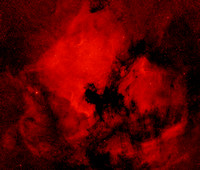 |
Green flash
from the
Caribbean Sea - Nov 23, 2011
The green flash can sometimes be seen at sunrise or sunset. This video shows
one captured at sunset from the Deck of the Rotterdam cruise ship on Nov 23,
2011 while sailing in the Caribbean sea. Look for the flash just as the sun
drops out of sight into the sea.John
McDonald |
|
|
The Great Nebula in Orion - Nov 20, 2011 This is an image of the
Orion Nebula (M42) and the Running Man nebula. The widefield data (primarily
the Running man) was taken on November 20th with my SVR90t on the clubs
HEQ5. The Main nebula is a composite, featuring the widefield data plus 4
hours from my CPC taken last December 29th, and January 2nd.
Daniel Posey |
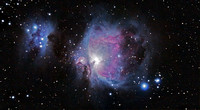 |
|
Sunspots - Nov 10, 2011 I had a look at the sun with a Baader foil
filtered 10x42 binoculars on Nov 10, 2011 and could see 13 sunspots. This
image shows even more.
John
McDonald |
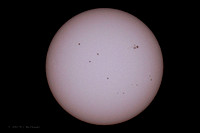 |
|
Open Cluster NGC 6791 - Oct 30, 2011 The motivation for imaging
this faint cluster of stars came after failing to visually observe it last
week. The open cluster NGC 6791 is located in the constellation of Lyra, has
a magnitude of 9.5, and is approximately 10 arc minutes in diameter.
Charles
Banville |
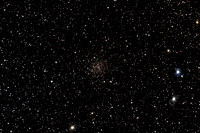 |
|
27 day old Moon over Victoria's Inner Harbour - Oct 24, 2011 A
27-day-old moon rises above one of Victoria�s iconic landmarks the Empress
Hotel at 6:00AM PDT.
Charles
Banville |
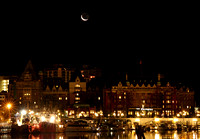 |
|
M45 - The Pleiades - Oct 9, 2011 Captured under the nearly full
moon, this picture continues to surprise me. 1 hour of 30 second exposures
through my SVR90T mounted on the club's HEQ5 Pro. Bias, Dark and Flat frames
used for calibration.
Daniel Posey |
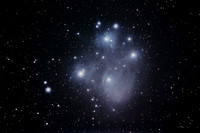 |
|
Orion in Ha - Sept 29, 2011 I got up at 4 AM this morning and
found that it was pretty clear. I used the opportunity to do a moderately
deep image of some of the hydrogen clouds in the Orion constellation. It is
amazing how much glowing gas can show up when using an H-alpha filter and
modified
camera that is sensitive to it. Makes it easy to accept the evidence
that the universe is mostly hydrogen.
This image was taken with a 100 mm lens so it covers a pretty wide field
but you should be able to pick out the Horsehead and Flame nebulae as well
as M 42, 43 and 78. If you look carefully at the outer edge of Barnard's
loop you should also see a dark nebula that appears to be LDN1622. North is
to the left.
John
McDonald |
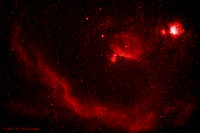 |
|
Jumbo Rocks at Joshua Tree National Park - Sept 25, 2011 Kemble's
Cascade and Double Persei Cluster rise above the Jumbo Rocks in this
California desert. We waited for car lights to illuminate the rocks.
Michel
Michaud |
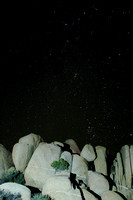 |
|
Startrails at Joshua Tree National Park - Sept 25, 2011 I had a
chance to spend one night in Joshua Tree National Park. Exposure: 203 light
frames of 30 seconds, f/4, ISO 800 using a Canon 7D dSLR
Charles
Banville |
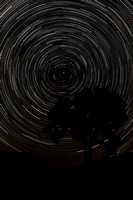 |
|
Orion is back - Sept 9, 2011 I could not wait for Orion to appear
in the evening so got up to image it around 4 AM on Sept 10, 2011 after the
moon set. There was about 2 hours of darkness to use and who needs sleep
when Orion is up?
The image was done at 100 mm focal length with a macro lens on a modified
Canon T1i and guided HEQ 5 mount all in my backyard. There is quite a bit of
detail that will show up best if you use the slideshow option.
John
McDonald |
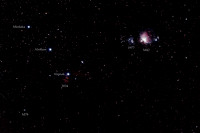 |
| Galaxies within 10� of the North
Celestial Pole - Aug 25 - Sept 5, 2011 Over this past new Moon period
along with working on my Herschel 2500 project I went on a trek to the North
Pole. On a popular internet forum a bit of a joke challenge went out to
observe 50 galaxies within 10 degrees of the pole. This peeked my curiosity
so I fired up Megastar and put in a few limits and came up with a chart of
the pole with all galaxies that my 12.5" scope should be able to pick up.
There are probably close to 100 galaxies on this chart and being the bit of
an obsessive that I am, I NEEDED to find them.
I started on the night of August 25th and rather easily found 8. I was
immediately hooked. I finished up the list on the night of Sept 5th by
staying up late and close to Moon set to log the last 3. It took a total of
5 sessions to log 8 NGCs, 6 ICs, 26 UGCs, 6 PGCs, 2 MACs, 1 MGC and 1 CGCG
for the total of 50. I actually could have finished sooner but I lost count
of where I was on the night of the 4th because I also wanted to take
advantage of the ubber excellent conditions we had this past weekend to work
on the Herschels.
I won't get into the gritty boring details of all these very faint and
small galaxies but I will say that I was surprised at the detail I could see
in many of them. For all but the NGCs and ICs the descriptions are mostly
small to very small and faint to extremely faint. Magnifications used varied
between 181X up to 456X to tease out those tiny faint ones. . My favorite
view was of the core of the Abell Galaxy Cluster 2247 where I was able to
see 6 all within one 300X FOV. The chain of galaxies that comprise the
brightest of the NGC 2300 group was also wonderful.
The galaxies that I observed listed by catalogue are.
 | NGC 1544, 2268, 2276, 2300, 2336, 3057, 3172, 6251 |
 | IC 440, 442, 469, 499, 512, 1143 |
 | UGC 115, 392, 1285, 3410, 3435, 3500, 3528, 3549, 3654, 3661, 3670,
3993, 4078, 4262, 4601, 5658, 8264, 9205, 9650, 9668, 10054, 10222,
10280, 10471, 10923, 11495 |
 | PGC 6510, 59174, 59211, 59212, 59122, 59143 |
 | MAC 0116+8459, 1651+8130 |
 | MCG +14-07-021 |
 | CGCG 362-35 |
Bill
Weir |
|
Triangulum Galaxy, M33 - Sept 3/4, 2011 This night the seeing
conditions were excellent at Pearson - no layer of marine air. I am
astounded with the resolution of my image.
Taken from LB Pearson College of the Pacific, Metchosin, using an
Astrotech AT8RC telescope, an EQ6 mount autoguided with Orion Autoguider
camera and PHD software. Orion SSPro, v1, MaximDLE software.
Guy
Walton |
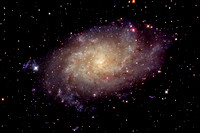 |
| Andromeda Galaxy, M31 - Sep 2, 2011
This is my first crack at the image of M31. John helped me capture last
night.
Daniel Posey |
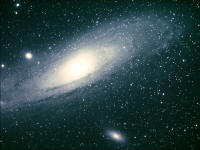 |
|
The Fireworks Galaxy, NGC 6946 - Sep 2/3, 2011 This night the
seeing conditions were excellent at Pearson - no layer of marine air. I am
astounded with the resolution of my image. I wonder if 15 minute subs
helped.
Taken from LB Pearson College of the Pacific, Metchosin, using an
Astrotech AT8RC telescope, an EQ6 mount autoguided with Orion Autoguider
camera and PHD software. Orion SSPro, v1, MaximDLE software.
Guy
Walton |
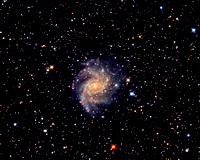 |
|
Island Star
Party 2011 Astrophotos - taken by Victoria Centre members John
McDonald and Joe Carr
|
|
|
The Perseid Meteor
Shower - Aug 11, 2011
Meteors recorded by a Sandia Bolide
Detection Camera. Slow motion (0.5x) applied to the three video clips.
"The Perseids were more or less a washout from my observatory in
Courtenay in the Comox Valley. Not only was a near full Moon present but
there was a lot of haze and scattered clouds over my site. As a result I did
not set up any cameras or spectrographs. Over two nights, the Sandia All-sky
only captured 3 meteors through holes in the clouds. I've never seen a year
like this with mostly cloudy weather. I hope this is not a sign of things to
come."
Ed Majden,
Courtenay, BC. |
|
|
Helix Nebula, NGC 7293 - August 3/4, 2011 I have been taking
advantage of this great weather and doing images of summer objects:
Helix Nebula,
Cocoon Nebula, and
Iris Nebula from LB Pearson College of the Pacific.
Guy
Walton |
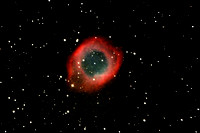 |
|
Comet 2009 P1 Garradd
& M15 Star Cluster - August 3, 2011 The comet was still near M15
last evening and I imaged it from my back yard with an 80mm telescope. This
image combines 23 frames to show the comet and star cluster.
John
McDonald |
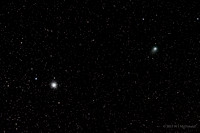 |
| Vesta - July 31, 2011 With all the
interest around Vesta these days I asked Bill Weir if he could observe the
asteroid on Friday night. Turns out that's a lot more difficult to
accomplish without charts and knowing exactly where to look. Well Last night
at the VCO I imaged around the known position of 4 Vesta for about 25
minutes.
After processing my images I looked for angular movement but could not
find anything obvious in my photo (Vesta has an sky motion of about
0.63"/min at this time). I then compared my photo to a sky view using
TheSky6 and downloaded an image of the area from the Digitized Sky Survey.
After doing that it was fairly easy picking out Vesta. At magnitude 5.7, it
is the brightest object in this photo (in the centre).
Charles
Banville |
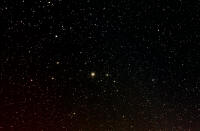 |
| Ha Solar & Deep Sky - July 29-31, 2011 -
RASCals Star Party 2011 John
McDonald and Joe Carr
captured Ha Solar images during the day, and Charles
Banville captured some deep sky images at night at the Star Party
despite windy conditions.
Several large prominences and surface detail including two sunspots were
observed and photographed. Charles captured wide field photos of some
regions in the Milky Way. Several members visually observed Comet
C/2009 P1 (Garradd).
RASCals Star Party 2011 Astrophoto Collection |
|
|
M8 & M20 - July 22, 2011 I went out to Pearson College last night
and was treated to excellent seeing conditions until about 1.00 am when the
moon decided to take over the sky. The sky was clear right to the mountains
behind Port Angeles with no clouds or fog. Here is an image I did of M8 and
M20.
Guy
Walton |
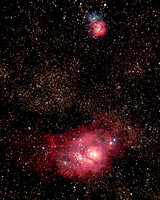 |
|
Janssen Crater - July 19, 2011 A close-up of the moon centred on
the large Janssen Crater (199 km). The large crater inside Janssen is
Fabricius Crater (78 km) and Metius Crater (87 km) just above it. At six
o�clock is a smaller crater sitting on the terraced wall of Jassen: Lockyer
Crater (34 km). At the bottom of this photo are two large craters that have
their central peak illuminated by sunlight. From left to right: Vlacq Crater
(89 km) and Rosenberger Crater (95 km).
Charles
Banville |
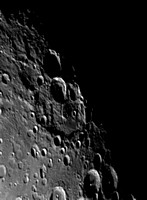 |
|
Veil Nebula - reprocessed July 19, 2011 This is a topographic
rendering of an image of the Veil Nebula, NGC7960, taken through an H-alpha
filter.
John
McDonald
|
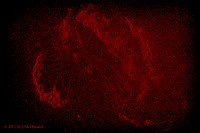 |
|
Milky Way widefield - July 6, 2011 A wide field image of our
galaxy showcasing some of the most interesting deep sky objects in
Sagittarius, Ophiuchus, Serpens Cauda, and Scutum. Taken from Pearson
College Observatory.
Charles
Banville |
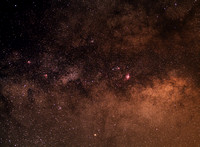 |
|
Double Exposure - two ISS passes - June 14, 2011 This morning
three bright ISS passes occurred above the city. In this image I captured
two of those from the DAO. I witnessed the first pass at around midnight
(the brighter of the two in this picture). The second pass occurred
approximately 90 minutes later.
Charles
Banville |
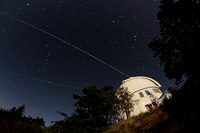 |
|
Gassendi Crater - June 11, 2011 Although this image suffers from
processing artefacts it is still an interesting picture. On Saturday
evening, volunteers and public at the CU observed a bright moon with
fascinating features on its terminator. One of those was the crater Gassendi
seen in the photograph. Half of Gassendi crater was in shadow with its
central peak illuminated by sunlight. Below the crater is Mare Humorum.
Charles
Banville |
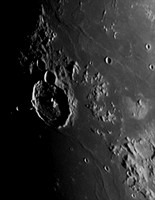 |
M51 Whirlpool Galaxy with SN 2011dh - June 4, 2011 1:00AM PDT
Whirlpool Galaxy is host to supernovae on a regular basis. This SN was
discovered on May 31st by French amateur astronomer Am�d�e Riou. This photo
was taken from the Victoria Centre Observatory using the QSI 583c CCD camera
on the 14" Meade LX-200 operating at f/10.Joe Carr |
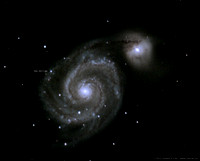 |
|
Supernova SN 2011dh in M51 Whirlpool Galaxy - June 3, 2011 This
supernova was spotted on May 31st, when French amateur Am�d�e Riou noticed a
previously absent 14th-magnitude star in CCD images of the Whirlpool galaxy,
M51, roughly 31 million light-years distant. The image shows two views of
M51 taken in Victoria, one well before and the other shortly after the
supernova appeared. This photo was taken from the Victoria Centre
Observatory using Canon T1i camera on the 14" Meade LX-200 operating at
f/10.
John
McDonald |
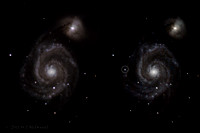 |
|
The Rival of Mars, Rho Ophiuchi Nebula - June 3, 2011 Scorpius
never rises very high in this part of the world. As a consequence,
diffraction and light pollution makes imaging the Antares Nebula
challenging. Initially this photograph covered a very wide field but a large
section had to be cropped. Antares, Messier 4, the Rho Ophiuchi Nebula, and
a number of dark nebulae are but some of the objects of interest. This
region of the sky is one that I will surely be revisiting in the near
future.
Charles
Banville |
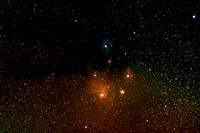 |
|
M101 Topographic Topographic representation of an image of M101
done with AIP4win software. The inset in the corner shows the original image
which was done by Joe Carr and John McDonald on July 2 & August 2, 2008.
M101, the Pinwheel Galaxy is a beautiful spiral that we can see face on
from our location. This image is a combination from two sessions at the
Victoria Centre Observatory one by Joe Carr and one by John McDonald.
It is the deepest image we have obtained so far with the new facility.
John
McDonald |
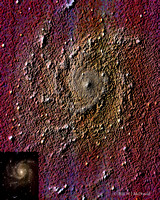 |
Supernova 2011by in NGC 3972 - Apr 30, 2011
Image of the recent supernova in NGC 3972 in UMa.
Image taken at the Dominion Astrophysical Observatory using the 1.8m
Plaskett telescope with CCD camera. Dave Balam, Telescope Operator.
Sherry
Buttnor
|
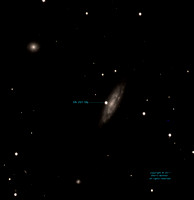 |
ARP 214 - NGC 3718 - Apr 30, 2011
ARP 214 is one of the most beautiful of the peculiar galaxies catalogued by
Halton Arp. In this image it is the largest galaxy. NGC 3729 is to its upper
left in this image.Image taken at the Dominion Astrophysical Observatory
using the 1.8m Plaskett telescope with CCD camera. Dave Balam, Telescope
Operator.
John
McDonald |
 |
| Pearson College Observatory -
April 22-23, 2011 Last night Nelson and I met out at Pearson, both
armed with list too large for a sane observer to pack. This past evil
winter/spring (OK you could even add autumn) did serious damage to our
progress. Despite the less than perfect transparency we both had a wonderful
and productive evening. Early on it seemed we both tended to have our scopes
pointed somewhat towards the west as we tidied up some missed objects.
With regards to the imagers, if you are looking for an interesting
grouping came across a trio of edge on galaxies in north western Virgo. It
centres on fabulous NGC 4216 which is bracketed by NGC 4206 and NGC 4222.
They all fit within about a 1/2� FOV. I also had a wonderful look at Abell
galaxy cluster 779 on the border of Leo Minor and Cancer.
At 0200 we both left the observatory as the transparency was fading and
the temperature had dropped to 1� C. Also by then the Moon was just starting
to rise. We both had a very successful evening with Nelson saying he had
logged 12 (if I remember correctly) new objects and I managed a total of 23.
Bill
Weir |
|
Witch Head Nebula - Aprill 1, 2011 A very faint nebula near the
star Rigel in Orion that appears to be the face of a Witch with a large hat.
Taken at the Painted Pony resort, Rodeo NM during a star party sponsored by
All-Star Telescope.
John
McDonald |
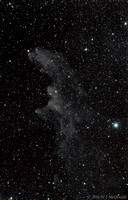 |
|
New Mexico Sky - March 30, 2011 Image of the southern sky during
the 2011 All-Star Alberta Party held at the Painted Pony Resort in SW New
Mexico. Bruno and I are enjoying it. I have uploaded 2 images from the first
night which may give you an impression of the very dark skies here. We had
an excellent night when these were taken.
Explore John's gallery for many more images taken from this dark desert
location, including: Zodiacal Light, Milky Way, Centaurus A galaxy, Omega Centauri globular cluster, star trails & fish eye
shots. John also assembled
three time lapse videos
.
John
McDonald |
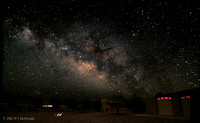 |
|
Solar prominences and sunspots in Ha - March 23, 2011 3:57pm PDT
This afternoon's high cloud cover wasn't conducive to observing the Sun in
Ha, however it was many months since my last solar observation, so I decided
to have a go anyway. The Sun had two huge prominences floating into space,
with many smaller spiky prominences visible all around the edges.
Once processed with the Sobel edge detection method, the soft contrast of
the original photos disappeared, revealing a surprising amount of detail. I
visually observed some small sunspots, and they also survived the Sobel
processing.
Joe Carr |
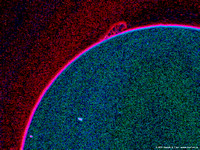 |
|
Moon - Apparent Size This is a comparison of the size of the "supermoon"
on 2011-03-19 (right) with images taken with the same lens on 2007-08-28
during a total lunar eclipse (centre) and during the partial phase of
another total eclipse on 2010-12-20 (Left). Lines above and below help to
show the apparent size difference and measured values for the relative
diameters (reproducible to 0.2%) are given.
John
McDonald |
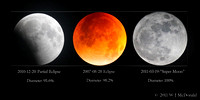 |
|
Twin Quasar Q0957+561 - March, 2011 The Twin Quasar Q0957+561 (the
two dots in the circle) are the two components of a double-imaged quasar
created by gravitational lensing. The quasar is located at 7 800 000 000
light year away and shine at a bright magnitude of 16,7.
Michel
Michaud |
 |
|
Centaurus A (NGC 5128) - March 3, 2011 Centaurus A (also known as
NGC 5128) is a prominent galaxy in the constellation of Centaurus only
visible from low northern latitudes and the southern hemisphere. Note the
bright central bulge and dark dust lane.Taken from La Ensenada Lodge in Costa Rica.
Explore John's gallery for many more images taken from this dark desert
location. John also assembled an
overnight time lapse
video.
John
McDonald |
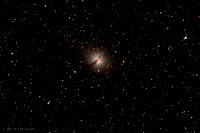 |
|
Omega Centauri - March 2, 2011 This spectacular star cluster is
located in the constellation Centaurus and is about 15,800 light-years from
Earth and contains several million stars. It is about 12 billion years old.
Taken in the early morning from La Ensenada Lodge in Costa Rica.
John
McDonald |
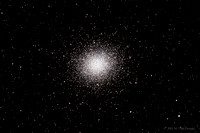 |
|
2 Day old Moon - Mar 6, 2011 2 day old Moon taken from the
Victoria Centre Observatory. Telescope: Tele Vue NP 127 apochromatic
refractor. Camera Nikon D70s.
Malcolm
Scrimger |
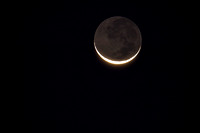 |
|
Moon &
Lighthouse - March 2, 2011 The lighthouse of Georges Island,
operational since 1876, is framed as the moon rises near Halifax, Nova
Scotia.
Charles
Banville |
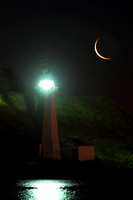 |
|
The Whirlpool Galaxy M51 - Dec 29, 2011 & Jul 6, 2010 A
combination of 48 minutes of 45 second exposures from December 29th 2010,
and 2 hours of 15 second exposures from July 6th 2010. All through my cpc800
in alt/az with a Canon XSi at iso 1600, darks and bias frames used.
Daniel Posey |
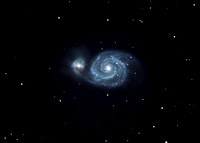 |
|
The hunter, Orion, trails above the Prince of Wales Tower in Halifax -
January 22, 2011 Built by the British army in 1797, the Prince of
Wales Tower was one of numerous fortifications that defended Halifax from
enemy attack. The tower�s main purpose was to protect the landward
approaches to the gun batteries located along the shores of what is now
Point Pleasant Park.
Charles
Banville |
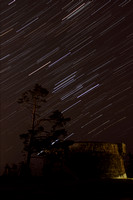 |
|
Citadel Moon - Jan 17, 2011 A waxing Gibbous Moon rises over the
Halifax Citadel. I finally had a clear night in Halifax and headed to
Citadel Hill where I setup my camera.
Charles
Banville |
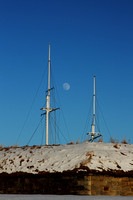 |
|
Moon Halo - Jan 17, 2011 As we were leaving the Astronomy Cafe
last evening Malcolm was looking up and pointed out a moon halo. It was a
bit dim but I thought it might be worth photographing so when I got home my
cobbled up fisheye lens came out. I took several exposures from 4s to 30s at
f/6.6 and ISO 400 to control the range of light intensities and combined
them in Photoshop. The result turned out well.
John
McDonald |
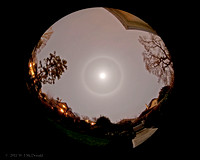 |
|
Horsehead Nebula (B33) - Jan 13. 2011
Daniel Posey |
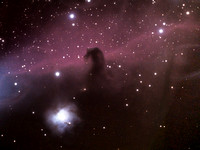 |
|
3 day old Crescent Moon - Jan 7, 2011 This 3 day old Crescent Moon
was photographed at dusk, while the sky was still a dark blue colour.
My first astronomy photo for the new year!
Joe Carr |
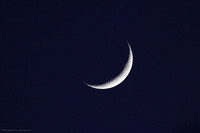 |
|
Horsehead & Flame Nebulae - Jan 2, 2010
An H-alpha enhanced image of the Horsehead and Flame Nebulae taken on two
dates using two different telescopes, both from my backyard in Victoria.
John
McDonald |
 |